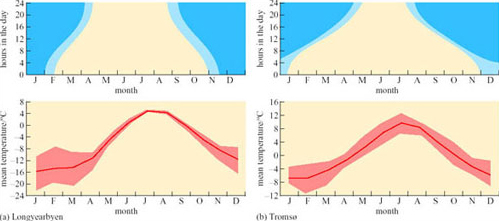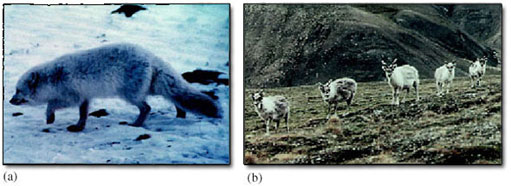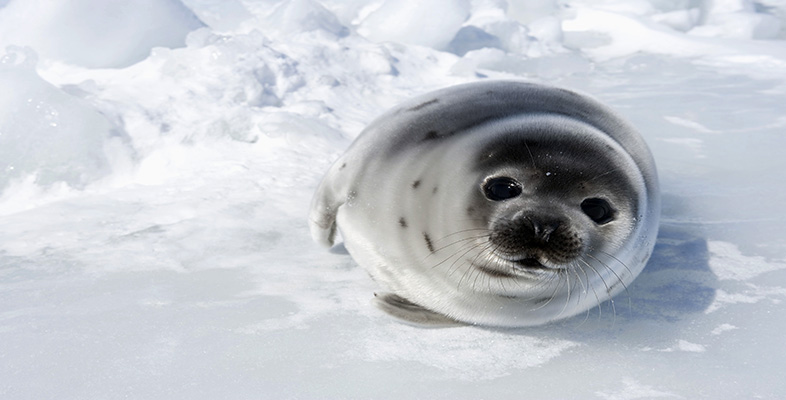1.2 The polar environment
At high latitudes, the Sun's rays always strike the Earth at a large angle from the vertical so they travel through a thicker layer of atmosphere and are attenuated by the time they reach the ground. Because the Earth's axis of rotation is inclined to its path around the Sun, there are large seasonal changes in daylength and the Sun is continuously below the horizon for a period in winter and continuously above the horizon for an equivalent period in summer. The annual changes in daylength and average temperature recorded just inside the Arctic Circle (at Tromsø, Norway) and far into the Circle (at Longyearbyen on the island of Spitsbergen, Svalbard Archipelago) are summarized in Figure 1. The range of annual temperature change is much greater at the higher latitude, and in mid-winter (January and February), the range about the mean is more than 12° C. In polar climates, the temperature can change abruptly and often unpredictably. In fact, both the localities featured on Figure 1 are on coasts, where the sea keeps the climate much more equable. Further inland, fluctuations in temperature are even greater. Polar organisms are thus adapted both to the extreme cold and to abrupt fluctuations in temperature.
The Arctic Circle (66° 30′N), and the equivalent latitude in the Southern Hemisphere, are defined as the latitude above which the Sun is continuously below the horizon for at least 1 day each year. Warm, moist air from the temperate zone rarely reaches high latitudes, so in most polar areas precipitation is low. Much of the water is locked away as ice, which has a low vapour pressure, and the air is very dry (often as dry as a tropical desert) and ground water is inaccessible to plants as well as to animals.
Terrestrial environments in the Arctic are, by geological standards, relatively new, most of the land having been completely covered with a thick layer of ice as recently as 10 000 years ago. Consequently, the soil is thin and fragile, and poor in organic nutrients. The optimum temperatures for plant growth do not coincide exactly with peak sunshine. At Longyearbyen, continuous daylight begins in late April, but the mean temperature does not rise above 0° C (and so the snow and ice do not melt) for another 2 months (Figure 1).

These circumstances, combined with the severe climate, mean that the growing season for plants is short but intensive, and total productivity on land is low, producing little food and still less shelter for animals. Consequently, relatively few species of terrestrial organisms live permanently at high latitudes. For example, although the land area of Svalbard is about 62 000 km2, almost half that of England, there are only a few hundred species of insects and other invertebrates, two resident terrestrial mammals, the arctic fox (Figure 2a) and reindeer (Figure 2b), one bird (an endemic species of ptarmigan) and no reptiles, amphibians or completely freshwater fish. However, many other species spend part of the year on or near the land, often while breeding or moulting: seasonal visitors include more than 30 species of migratory birds (various kinds of geese, auks, puffins, skuas, terns, gulls, and eider ducks and snow buntings), and mammals that feed in the sea, such as polar bears, walruses and several species of seal. The simple ecosystem on land and the severe, erratic climate tend to produce ‘cycles’ of population abundance followed by mass mortality or migration (e.g. lemmings in Scandinavia and Russia). Interesting physiological and behavioural adaptations to these fluctuations in food supply have evolved in some of the larger animals. The vast continent of Antarctica has no indigenous terrestrial vertebrates, although many birds, including penguins, skuas, terns and gulls, and six species of seal spend time on or near land.

Only two species of terrestrial mammal occur naturally throughout the year on Svalbard (although a few others have been introduced by humans during the past century). Figure 2a shows the arctic fox (Alopex lagopus), which also occurs throughout the Arctic, and in mountains at lower latitudes. The picture above, taken in late autumn, shows an adult in its long, dense winter coat. The summer coat is usually greyish brown, often with white markings. Alopex is bred in captivity for its fur, which can vary in colour from grey to bluish in winter, and chocolate brown to fawn in summer, hence the common names, silver fox or blue fox. Figure 2b shows a subspecies of reindeer (Rangifer tarandus platyrhynchus) that is endemic to Svalbard. This picture was taken in July, when the vegetation is at its highest, and these young males are growing antlers for the mating season in September
The situation in the sea is very different. Seawater freezes at −1.9° C, but because of the anomalous relationship between the density and temperature of water, ice floats, insulating the water underneath from the cold air above. Except in very shallow areas, the sea-ice does not extend to the sea-bed, even at the North Pole. Storms and currents sometimes break up the ice, creating many temporary, and some permanent, areas of open water even at high latitudes in mid-winter. Such turbulence also oxygenates the water and admits more light, making the environment much more hospitable to larger organisms.
The movements of ocean currents are complex (and may change erratically from year to year), often resulting in an upwelling of deep water rich in nutrients and promoting high primary productivity in the sea. In most arctic regions, the sea is both warmer and more productive than the land, so at high latitudes there are many more organisms in the sea than on land, at least during the brief summer, and, as in the case of the baleen and sperm whales, some are very large. Some groups of animals, such as bears, that are terrestrial in the temperate zone, have evolved adaptations that enable them to feed from the sea in the Arctic.
Sea-ice is less compact than freshwater ice, and contains many tiny channels containing liquid water as well as cracks caused by weather and currents. Hence sea-ice appears opaque rather than transparent like freshwater ice. The pores harbour a variety of single-celled algae, bacteria and other microbes that form the basis of surprisingly productive food chains. Most of those living on or near the surface are photosynthetic, and during the summer, such microbes are dense enough to confer a brown colour on the underside of the sea-ice. These organisms, and similar ones living on snow and in cold, dry terrestrial habitats, are collectively known as psychrophiles (ψυχρoσ, psychros=cold, Φιλoσ, philos=friend). The continent of Antarctica is generally much colder at comparable seasons and latitudes than most of the Arctic, with the possible exception of large landmasses such as Siberia, Alaska and some of the bigger islands off the north coast of Canada. With its harsher climate, and longer period of biological isolation, Antarctica has a wider variety of endemic, impressively adapted psychrophiles than most of the Arctic.
